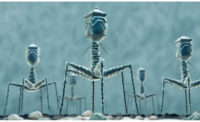Bacteriophages: Advantages grow research




Nature’s way of killing bacteria is to use bacteriophages (phages). In addition to being natural, these viruses that kill bacteria have several advantages that the industry is just beginning to appreciate. An import benefit of phages is specificity.
“You can target to the species level and even the strain level with phages,” explains Jason Gill, an assistant professor in the Department of Animal Science at Texas A&M University, in College Station.
Because phages are biological, they are safe to use, Gill says. In addition, because the actual amount of active ingredient in a phage product by weight is extremely low, phages do not create any organoleptic challenges.
“They are pretty much invisible as far as putting them on,” Gill explains.
Phages also are abundant and easy to isolate, says Paul Ebner, associate professor of animal sciences at Purdue University, West Lafayette, Ind. Still, several unanswered or understudied questions exist, such as how efficacy may be affected longer term in real-life scenarios by resistance, he says.
“While phages, by their nature, are very specific, it’s not well-known their impact on the microbiome in general,” Ebner says. “These aren’t really limits, but knowing these answers would allow us to more accurately predict where the use of phages would be most effective and appropriate.”
Scientific research is being done in those areas, but also using only portions or products of the phages or using them as vehicles to deliver other types of antibacterials to targeted pathogens, he adds.
An explosion of bacteriophage research in all aspects of preventing and treating animal, human and plant diseases as well as in food-safety applications is occurring, says William Huff, a retired research microbiologist at the U.S. Department of Agriculture’s Agricultural Research Service at the Poultry Production and Product Safety Research Unit at the University of Arkansas in Fayetteville. For example, it may be possible to use phages as a natural environmental disinfectant or isolate and use the enzymes that phages produce that kill bacteria to do the same for processors as a targeted antibacterial product. Modifying the phages to make them more effective also is being studied, Huff says.
Phages are being used as a finishing step for various food processes, such as for ready-to-eat meats. Phages are also being used on the live side of the processing chain to spray the hides of cattle before slaughter to decontaminate for E. coli O157:H7. Much work is being done looking at other applications, Gill says, and many of them deal with pre-harvest prevention to aid food safety. For example, Texas A&M is researching the use of phages to reduce the carriage of Salmonella in the lymph nodes of cattle, which could reduce Salmonella contamination in ground-beef products. The university has another project controlling Staphylococcus aureus in swine. Other researchers are working on controlling Salmonella and Campylobacter in poultry with the help of phages.
Phage efficacy
Although specificity is one of the advantages of phages, it is also one of its disadvantages. “Depending on what you are going after you will probably need a few phages to give decent coverage of the different strains that you are trying to go after,” Gill says.
For example, Listeria isn’t genetically diverse, so processors wouldn’t need to use as many phages to eliminate the bacteria. On the other hand, Salmonella is very diverse and would demand a mixture of phages to combat the bacteria.
Phages also have some advantages and disadvantages with stability. Because phages are simply made out of protein and sensitive to extremes in pH and temperature, compatibility issues with other treatments do occur, Gill says.
For example, if a processor wants to get rid of the phages, one could put a product through a heat treatment or pasteurization step, and the phages would be destroyed, Gill says. On the other end of the spectrum, phages may not work in frozen applications either. Phages also can’t exist with organic acids used in the beef industry.
“For pre-harvest and for post-harvest, the big issues for phages are, because they are biological, the host has to be in a particular state for them to really be most effective,” Gill says.
In turn, using phages in certain areas makes more sense than others. For example, if a processor is using them for food safety, particularly in later stages, then phages work best in minimally processed and fresh foods, where not many processing interventions are being used, Gill says.
While there aren’t a great number of challenges, in terms of live animals, it takes some time to develop any sort of safe and effective antibacterial and receive approval. “With phages, though, it will happen,” Ebner says.
Working with phages also will continue as the industry searches for ways to limit antibiotics in animal production and to aid fighting antibiotic-resistant bacteria.
“If antibiotics become unavailable or much more restricted, then it will really be beneficial to the industry to have a replacement for that and particularly because phages work fine on antibiotic-resistant bacteria,” Gill says.
Another issue that phages will have to address is how bacteria change in the environment. Phages now are marketed like any other food safety intervention, Gills says. The phage market may need to evolve to be a subscription service where processors contract with a company to take care of, for example, Salmonella on a per-flock or per-plant basis.
“Because the bacteria you are trying to combat are out in the environment and they are out in the open world, the pathogens that are out there are constantly changing,” he says. “New bugs come in and old ones move out. You still are going to have to be constantly upgrading and updating your phage product to respond to what the current bacteria situation is out in the field.”
Huff believes the top challenges that bacteriophage have is industry acceptance along with increasing bacteriophage efficacy, learning how to most effectively administer bacteriophage products, and looking for novel applications for the use of bacteriophage.
“Most, if not all, bacteriophage work — they kill bacteria,” he says. “We simply need to understand how to use this vast potential.”
Looking for a reprint of this article?
From high-res PDFs to custom plaques, order your copy today!












